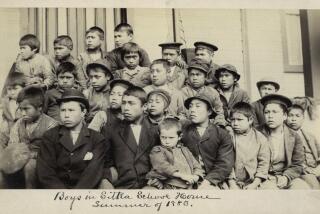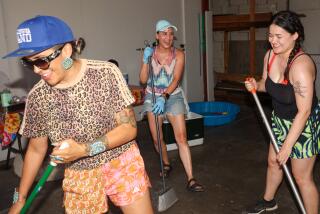New Acceptance for ‘Wolves’ Generation
IRVINE — The matter of ethnic salvation is no passing fad for Elizabeth Whipple, born 24 years ago on a desolate reservation in the South Dakota heartland of the Sioux nation.
Her generation was raised to always remember the tragic side of their American Indian legacy--their Wounded Knees, their segregation and lost lands, their descent into cultural oblivion and destitution.
But her generation was also taught never to surrender their American Indian self, never to disown the traditional, closely woven ways of family, tribe, land and spirit.
“I’ve always felt proud of being an Indian, that our heritage was a special gift,” Whipple, a UC Irvine dance major, said as she sat on a campus patio before the weekly parley of the tiny--only 20 active members--but energetic American Indian Council at Irvine.
Now, these Indian council students say, there appears to be a shift in the winds in white American society. It seems that their Indian heritage--after generations of curio status in museums and souvenir shops, after a thousand Hollywood movies that had reduced revered chieftains to stock Injun figures--may be attaining a more favorable image among the masses.
And the timing couldn’t be better for celebrations of ethnic pride, such as the UCI council’s American Indian Culture and Education Days on Wednesday and Thursday at the UCI Student Center, and a similar open house and college-recruitment event, Friday and Saturday at the federal Sherman Indian High School in Riverside.
The emphasis of these events, the UCI students say, is to underscore this changing mood: That the American Indian experience isn’t just social ills and despair but one also of educational achievements and an emerging generation that has never abandoned its native legacy.
“Being an Indian is becoming more acceptable,” said Whipple, whose dark, broad, high-cheeked face is a strong reminder of her own direct ancestry--her father is Sioux, her mother Navajo.
With a smile that is slight and fleeting but just enough to underscore the irony of it all, Whipple added, “Indians, at least right now, are trendy.”
Attempts to resurrect the American Indian as a commanding cultural presence are hardly new.
The best-known efforts date back to the 1960s, when ethnic-pride movements of all kinds swept the country.
Such fervor led to more multicultural courses and research efforts at numerous California campuses, including programs devoted to the historical culture and modern problems of the native minority population, such as UCLA’s American Indian Study Center and Cal State Long Beach’s American Indian Studies Program.
If anything, the multicultural movement intensified in the 1980s, when the numbers of Latinos and Asians soared and even the American Indian population made dramatic gains--reaching 1.9 million in the 1990 Census, the highest reported in this century, and one attributed in large part to more Americans openly declaring their Indian bloodlines.
Yet UCI American Indian Council members, like others in the Southern California Indian communities, say the real breakthrough may be the effect of a single, immensely popular movie--”Dances With Wolves,” directed and co-produced by its star, Kevin Costner.
Filmed in South Dakota and set during the Civil War, “Wolves” tells of a young white man, Union Lt. John Dunbar, who is assigned to an outpost in the Sioux territory and learns the Lakota tribe’s ways, even adopting their dress and language, but who is ultimately hunted down with the Lakota by Army troops.
To those connected to the UCI council, the Costner production is notably limited--a film, they say, that is, after all, a romanticized, commercialized Hollywood product aimed at mass audiences.
“The focus, the true hero, is still a white man. From a historical standpoint, the story ends too abruptly, telling us nothing of what really happened to the Lakota and to the other Indians,” said council adviser Billie Masters, a coordinator of UCI’s teacher-training project at Sherman Indian High School and UCI’s Cherokee Language and Culture Institute.
But overall, Masters, who is of Cherokee descent, and the others with the UCI council have high praise for the Costner film.
“For once, we are presented as we really are--human beings with great depth of warmth and humor, a culture that is close to nature, very complex and diverse,” said UCI council chairman Hank Stevens, who is part Osage Indian. “We are seen as peaceful, not savage. We are even heard speaking our own language.”
Thus, if students with the UCI council are any example, the emerging 1990s generation of college-going American Indians--still a minority within a minority--are sounding somewhat more hopeful than their predecessors.
They see themselves, after all, as part of the post-”Wolves” generation.
In the previous generations, there were endless horror stories of cultural suppression, economic exploitation and profound despair under the paternalistic U.S. bureaucracy.
Indian activist organizations have pressed for greater self-rule in the tribal areas and restoration of key treaty lands and have denounced what they describe as gross mismanagement of Indian resources under federal guardianship.
Such militancy reached its height in the American consciousness in 1973, when American Indian Movement followers, seeking a national platform to publicize Indian grievances, seized Wounded Knee, the South Dakota hamlet near the site of the 1890 massacre of more than 200 Sioux.
But many American Indian communities, especially in the reservation and rural areas where nearly one-half of the population still live, remain devastated by poverty--the jobless rate is as high as 80% in many areas--alcoholism and other social ills.
“There is still a sense of hopelessness and lost opportunities, a feeling of being betrayed,” explained political science student Curtis Meeks, who has Cherokee and Choctaw bloodlines and is a member of UCI’s American Indian Council.
To no one’s surprise, the effect on American Indian educational aspirations has been disastrous.
According to the Coalition for Indian Education and the Native American Scholarship Fund, the high school dropout rate for American Indians--estimated nationally at 45% to 50% but as high as 85% in the most depressed areas--is the worst record of any major ethnic-minority group.
The number of graduating American Indians going on to some form of post-high school education, including colleges, is even more dismal--only around 20%, these national Indian organizations reported. And the number of those finishing a four-year college is believed to be minuscule.
A crucial reason, teacher-education supervisor Billie Masters and other UCI educational specialists argue, is the far lower expectations many hold for Indian students.
“This line of thinking, which is totally fallacious, is that Indian students seem fit only for remedial or basic vocational programs,” said Kogee Thomas, who is part Creek-Seminole and a coordinator of UCI’s college-preparation program for American Indians.
Indeed, specialists view UCI council members as successful examples of how educational motivation does work among American Indians, such as in the case of Jeanne Amos, a 20-year-old biological sciences major who is part Choctaw.
“My parents told us we have to go to college in order to survive and succeed in the white American society. There were no doubts about that, as long as we didn’t lose our Indian heritage along the way,” said Amos, whose plan is to return to Oklahoma, possibly to medical school there, and to build a house on land that still belongs to the family.
Anthropology major Carolyn Kuali’i, who was born in Oahu, Hawaii, and is part Apache, put it this way: “For such a long time, the concept in white society was total assimilation into their world. That was absolute, no ifs or buts. But now it’s finally becoming OK to be different--to be Indian.”
Nonetheless, Amos, Kuali’i and other Indian students still find themselves a tiny minority at UC Irvine, which last fall had 88 students who identified themselves as American Indians. The 1990 figures weren’t much better at the bigger UC campuses--318 at Berkeley, 290 at UCLA--while the total in the entire UC system was 1,436.
The situation is similar at Cal State University, where the systemwide total for American Indians last fall was 3,312, including 300 in Sacramento, 298 in San Diego, 271 in Long Beach and 211 in Fullerton.
“A lot of people still can’t figure out who we are. Some keep assuming I’m Mexican. Indian is something some people are not able to understand, that there are 500 different tribes and hundreds of languages still being spoken,” Amos said.
At the same time, UCI council members say, there is markedly increased interest in Indian culture, particularly since “Dancing With Wolves” came out, and usually focused on the American Indian’s spirituality and traditional reverence of the natural environment.
Moreover, UCI council members point out, population and ethnic-networking trends are fast expanding.
According to the Garden Grove-based Southern California Indian Center, which provides family, job and other community services, Los Angeles County now has 80,000 people who identify themselves as Indians, Orange County 20,000--the largest such urban concentration in the United States.
And at UCI, Indian students are playing direct roles--including as tutors, discussion leaders and research aides--in UCI’s year-round college-motivation “partnership project” with Sherman Indian High School in Riverside, the only such federally supported boarding school in California.
The other campuses represented in the 4-year-old partnership, which also involves upgrading curriculum and teaching methods at the 100-year-old institution, include UC Riverside, Cal State San Bernardino and Riverside Community College.
UCI council members also take part in the two-week college-preparation workshop held each summer at the university--the only one of its kind in the UC system. Last summer’s session, the first, involved 50 of the 400 students at Sherman. This summer’s workshop will be Aug. 18-28.
The UCI students are considered role models for the Sherman high school students, who represent 77 tribes and 12 states.
“These (UCI) students are making it in college, have plans to contribute to their heritage after they leave the university,” said Sherman Principal Joe Frazier, who is of Chickasaw descent. “In that way alone, they are absolutely vital to our program.”
More to Read
Sign up for Essential California
The most important California stories and recommendations in your inbox every morning.
You may occasionally receive promotional content from the Los Angeles Times.










